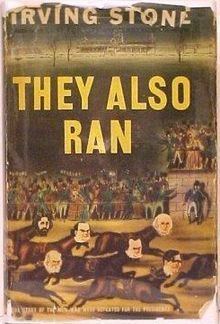7.6 /10 1 Votes7.6
Language English Dewey Decimal 920.073 Country United States of America | 3.8/5 Goodreads Publication date 1943 Originally published 1943 OCLC 421063 | |||||||||||||||||||||||||||||||||
 | ||||||||||||||||||||||||||||||||||
Subject U.S. political and electoral history Irving Stone books Adversary in the House, Clarence Darrow For the Defen, Depths of Glory, Men to match my mountains, Those Who Love | ||||||||||||||||||||||||||||||||||
2017 inaugural event of hrc in the they also ran gallery
They Also Ran: The Story of the Men Who Were Defeated for the Presidency (1943) is a non-fiction book about United States presidential candidates by American writer Irving Stone, known for his popular biographical novels of artists and intellectuals. An updated edition was published in 1966, with brief analyses of the 1944 through 1964 elections.
Contents
- 2017 inaugural event of hrc in the they also ran gallery
- They also ran america s would be presidents the 19th century
- Summary
- Structure
- Reception
- 1966 edition
- Influence
- References
They also ran america s would be presidents the 19th century
Summary
Stone evaluates several unsuccessful candidates for President of the United States, from the elections of 1824 through 1940. He explores their places in history (and those of their victorious opponents), and tries to assess whether or not the American people made the "right" choice in choosing another candidate for that office.
Structure
Stone groups the also-rans by profession, rather than listing them in chronological order. For example, the first section assesses newspapermen Horace Greeley and James M. Cox. Coincidentally Stone happens to rate them favorably compared to the candidates who were elected: Grant and Harding.
Reception
The Chicago Tribune described They Also Ran as "a fascinating and challenging book,"
The New York Times praised it as "a brilliant idea . . . brilliantly executed".
Boyd Lee Spahr in The Pennsylvania Magazine of History and Biography criticized the book's "lack of historical continuity" in its organization, complaining that the grouping of candidates by profession did little to increase understanding. He particularly criticized the text for numerous errors related to several different candidates, and said that Stone did not reflect the consensus of historians on many candidates. He said:
"Mr. Stone wields a trenchant pen but his penchant for striking sentences, and perhaps his prejudices, lead him into exaggerations and inaccuracies, with the result that some of the sketches seem like campaign propaganda, post-mortem pro or con, rather than impartial biography. In addition, factual errors are fairly numerous."
Spahr concluded that while Stone was entitled to his opinions, the inaccuracies decreased the book's value as a reference.
1966 edition
The book was published in an updated edition in 1966, incorporating material on elections from 1944 to 1964. It included the sections noted below:
